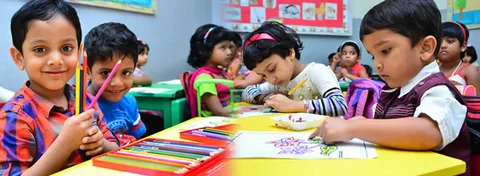Creating a safe and nurturing environment for preschoolers is essential to their healthy development. Preschoolers are at a critical stage of development, and the environment they are exposed to can have a significant impact on their social, emotional, and cognitive growth. In this article, we will discuss the key elements of creating a safe and nurturing environment for preschoolers.
- Physical Safety:
The physical safety of preschoolers is of utmost importance. Here are some key steps you can take to ensure their physical safety:
- Childproofing: Childproofing your environment is essential to keeping preschoolers safe. This includes securing cabinets and drawers, covering electrical outlets, and placing safety gates at the top and bottom of stairs.
- Safe Play Areas: Providing a safe play area for preschoolers is important. This includes using age-appropriate toys and equipment, providing soft surfaces to cushion falls, and supervising playtime to prevent accidents.
- Nutrition: Proper nutrition is essential to preschoolers’ physical growth and development. Providing a balanced diet with plenty of fruits, vegetables, and whole grains will help support their immune systems and overall health.
2. Emotional Safety:
Emotional safety is just as important as physical safety when it comes to creating a nurturing environment for preschoolers. Here are some key steps you can take to promote emotional safety:
- Positive Reinforcement: Offering positive reinforcement and praise for good behavior helps preschoolers feel valued and supported.
- Consistency: Consistency in rules and routines helps preschoolers feel secure and know what to expect.
- Responsive Caregiving: Responding promptly to preschoolers’ needs and providing a warm, supportive environment helps build trust and emotional security.
- Cognitive Stimulation: Preschoolers’ brains are rapidly developing during this stage, and cognitive stimulation is essential to support their learning and development. Here are some key steps you can take to promote cognitive stimulation:
- Play-Based Learning: Play is a natural way for preschoolers to learn and explore the world around them. Encouraging play-based learning through activities such as puzzles, blocks, and imaginative play helps support cognitive development.
- Reading: Reading with preschoolers helps build their vocabulary, literacy skills and fosters a love of learning.
- Hands-on Learning: Providing hands-on learning experiences through activities such as arts and crafts, science experiments, and cooking helps preschoolers develop problem-solving skills and creativity.
- Social Development: Social development is another essential aspect of preschoolers’ growth and development. Here are some key steps you can take to promote social development.
- Peer Interaction: Encouraging preschoolers to interact with peers in a safe and structured environment helps build social skills such as sharing, taking turns, and empathy.
- Role Modeling: Modeling positive social behavior and empathy can have a significant impact on preschoolers’ social development.
- Group Activities: Group activities such as singing, dancing, and playing games help preschoolers develop social skills and build relationships with peers.
- Conclusion:
Creating a safe and nurturing environment for preschoolers is essential to their healthy development. Focusing on physical safety, emotional safety, cognitive stimulation, and social development can help support preschoolers’ growth and development during this critical stage. By providing a warm and supportive environment, caregivers can help preschoolers develop into confident, curious, and capable learners.

